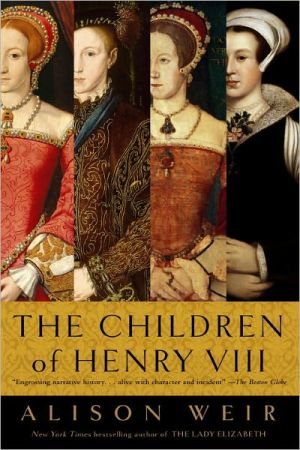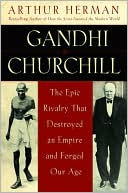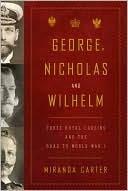The Children of Henry VIII
"Fascinating . . . Alison Weir does full justice to the subject."\ —The Philadelphia Inquirer\ At his death in 1547, King Henry VIII left four heirs to the English throne: his only son, the nine-year-old Prince Edward; the Lady Mary, the adult daughter of his first wife Katherine of Aragon; the Lady Elizabeth, the teenage daughter of his second wife Anne Boleyn; and his young great-niece, the Lady Jane Grey. In this riveting account Alison Weir paints a unique portrait of these extraordinary...
Search in google:
"Fascinating . . . Alison Weir does full justice to the subject."—The Philadelphia InquirerAt his death in 1547, King Henry VIII left four heirs to the English throne: his only son, the nine-year-old Prince Edward; the Lady Mary, the adult daughter of his first wife Katherine of Aragon; the Lady Elizabeth, the teenage daughter of his second wife Anne Boleyn; and his young great-niece, the Lady Jane Grey. In this riveting account Alison Weir paints a unique portrait of these extraordinary rulers, examining their intricate relationships to each other and to history. She traces the tumult that followed Henry's death, from the brief intrigue-filled reigns of the boy king Edward VI and the fragile Lady Jane Grey, to the savagery of "Bloody Mary," and finally the accession of the politically adroit Elizabeth I.As always, Weir offers a fresh perspective on a period that has spawned many of the most enduring myths in English history, combining the best of the historian's and the biographer's art."Like anthropology, history and biography can demonstrate unfamiliar ways of feeling and being. Alison Weir's sympathetic collective biography, The Children of Henry VIII does just that, reminding us that human nature has changed—and for the better. . . . Weir imparts movement and coherence while re-creating the suspense her characters endured and the suffering they inflicted."—The New York Times Book Review Publishers Weekly The tragedy of four accidental rivals to a throne, three of them childrenby different mothersof a much-married despot, seems to lose none of its drama by frequent retelling. Along with the royal siblings, Weir (The Six Wives of Henry VIII) includes their cousin, the doomed Lady Jane Grey. Guiltless of the intrigues committed in the name of religion, power and property, Queen Jane was forced at 15 to reign for nine days in a futile attempt to block the accession of the fanatically Catholic Princess Mary. The 300 burnings for heresy during the five years Mary ruled were eclipsed statistically by the hangings and beheadings for conspiracy and treachery. In the 11 years between the death of Henry VIII and the survival of his adroit daughter Elizabeth into the succession in 1558, rapacity had at least as much to do with the turbulence and the terror as religion. So many ennobled miscreants grasped for land, loot and legitimacy that readers will need a scorecard to match their names with their new titles. Weir adds nothing fresh to the story, but her sweeping narrative, based on contemporary chronicles, plays out vividly against the colorful backdrop of Tudor England. Illustrations not seen by PW. (Aug.)
This book is not a history of England during the troubled reigns of Edward VI, Jane Grey, Mary I and Elizabeth I, but a chronicle of the personal lives of four English sovereigns, and the relationships between them, during the period 1547 to 1558. When Henry VIII died in 1547, he left three highly intelligent children to succeed him in turn—Edward, Mary and Elizabeth, to be followed, if their lines failed, by the descendants of his sister Mary Tudor, one of whom was the ill-fated nine-days queen, Lady Jane Grey.\ The relationships between the royal siblings were never easy ones for several reasons: all had very dissimilar characters, and while they took after their father in many ways, they had each inherited diverse characteristics from their mothers, who had been the first three of Henry VIII's six wives. Each child had spent its formative years in vastly different circumstances, and had enjoyed—or suffered—varying relations with its formidable father. Mary's mother had been supplanted in King Henry's affections by Elizabeth's mother, who had, in her turn, been supplanted by Edward's mother. And while the King's daughters suffered several vicissitudes of fortune in Henry's lifetime, his son grew up secure in his august father's love and protection.\ In the pages of this book, which begins at the point where my earlier book The Six Wives of Henry VIII came to an end, I have tried to portray the characters of these royal siblings and their cousin Jane Grey as realistically as possible, and to describe how their personal relationships with each other were affected by political and religious considerations. In order to achieve this, I have consulted a wealth of documentary evidence contemporary to the period, including numerous private and official letters, the great calendars of state and the masses of diplomatic papers, as well as memorials and chronicles by contemporary writers, including Edward VI's own journal, and more mundane records, such as lists of privy purse expenses, which can in fact yield fascinating information.\ There have been many biographies of the later Tudor monarchs, but never a book in which their personal lives and relations with each other, and the effect of these factors upon the history of England, have been the central theme. One cannot of course write about kings and queens without touching on the political and social issues of their times, but what I have tried to bring into focus here is personal information that has until now been treated as generally subsidiary to the political ethos of other works. This book is not intended to replace such works, but to complement them.\ In these pages, we go back in time to an age in which the personalities of monarchs and their familial connections had the power to influence governments, and it is vital to our knowledge of the period to understand what shaped the characters of these four monarchs, who were among the most charismatic and vivid personalities ever to have graced the throne of England. Naturally, our human condition makes us eager to learn about the private things, the everyday trivia, the scandals, and the sheer "feel" of ages long gone. We want to bridge the gap, to discover that even these long-dead kings and queens felt as we do, and come to know them through the writings and mementos they have left behind. We are fortunate, therefore, that the Tudor period is one rich in source material, in which fascinating—and sometimes astonishing—discoveries may be made. These, and one or two tantalizing mysteries, are the things I have included in this book, the things that bring us closer to the past.\ Set against a background of turbulent change and intrigue, the story that unfolds will, I hope, bring to life four Tudor sovereigns and those whose lives they touched, and will portray them not only as Renaissance princes, but as individuals, who, in the final analysis, were people not so very unlike ourselves.
\ Publishers Weekly\ - Publisher's Weekly\ The tragedy of four accidental rivals to a throne, three of them childrenby different mothersof a much-married despot, seems to lose none of its drama by frequent retelling. Along with the royal siblings, Weir (The Six Wives of Henry VIII) includes their cousin, the doomed Lady Jane Grey. Guiltless of the intrigues committed in the name of religion, power and property, Queen Jane was forced at 15 to reign for nine days in a futile attempt to block the accession of the fanatically Catholic Princess Mary. The 300 burnings for heresy during the five years Mary ruled were eclipsed statistically by the hangings and beheadings for conspiracy and treachery. In the 11 years between the death of Henry VIII and the survival of his adroit daughter Elizabeth into the succession in 1558, rapacity had at least as much to do with the turbulence and the terror as religion. So many ennobled miscreants grasped for land, loot and legitimacy that readers will need a scorecard to match their names with their new titles. Weir adds nothing fresh to the story, but her sweeping narrative, based on contemporary chronicles, plays out vividly against the colorful backdrop of Tudor England. Illustrations not seen by PW. (Aug.)\ \ \ \ \ Library JournalWeir's latest biographical history begins where her Six Wives of Henry VIII (Grove Atlantic, 1992) ends, with Henry's death. Weir's new book covers the lives of Henry's children Mary Tudor and Edward VI, but it only takes Elizabeth up to her accession, and it also includes the entire short life of Jane Grey, the granddaughter of Henry's sister Mary. When Henry died in 1547, he left a country embroiled in several social problems brought about the enclosure of common lands, the high cost of his European wars, and the closure of monasteries. How his heirs dealt with these problems, along with their relationships, makes interesting reading, even though there's not a lot of new information here. What Weir provides is more detail, especially regarding Elizabeth's and Mary's interactions. We meet neither "good Queen Bess" nor "Bloody Mary" but rulers with strengths and weaknesses. Good reading for history fans.Katharine Galloway Garstka, Intergraph Corp., Huntsville, Ala.\ \ \ Kirkus ReviewsThis fascinating tale of murder, jealousy, religious fanaticism, and political scandal among 16th-century British royals makes the modern dysfunctional royal family appear quaint by comparison.\ Whereas the history of Henry VIII and his six wives is at least vaguely familiar to most, the fate of some of their offspring is less well known, though hardly less riveting. Weir (The Wars of the Roses, 1995, etc.), who has established herself as a skillful guide to English royal history, now examines the lives of the four heirs to Henry VIII's throne: Edward, Elizabeth, and Mary, all children of different wives, as well as the ill-fated Lady Jane Grey, Henry VIII's great-niece, who was executed by Mary. Weir's narrative brings to life both the tangled relationships of these figures and the violent religious tensions that dominated England during the 16th century. The contest between papists and reformists was directly played out by Henry VIII's heirs: Edward was a fanatical Protestant; Mary, a Roman Catholic, considered her life's work to be a reconciliation with Rome. Mary's religious beliefs dictated her every action, from her marriage (to Philip II, king of Spain) to domestic politics (the burning of reformist heretics), and earned her the epithet "Bloody Mary." Religious loyalties also galvanized the divided royal subjects, who staged rebellions with regularity during these turbulent years. Thus, even for the more moderate Elizabeth, who survived a variety of conspiracies to become queen, religious issues were always a significant factor. Weir is a practiced and polished writer whose prose moves at a brisk pace. Occasionally, though, her narrative gets bogged down with details about wardrobes and residences and other not entirely relevant matters.\ Nevertheless, Weir succeeds not only in bringing to life Henry VIII's heirs but also in illuminating the background to the aftermath of their turbulent years—the Elizabethan era.\ \ \







